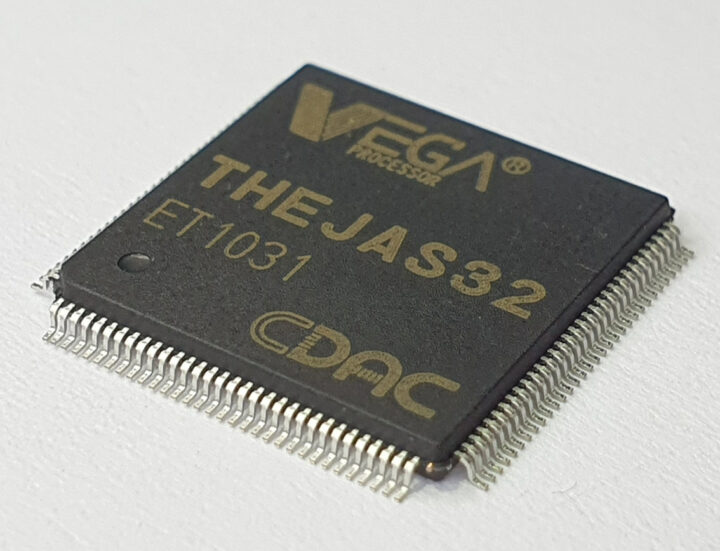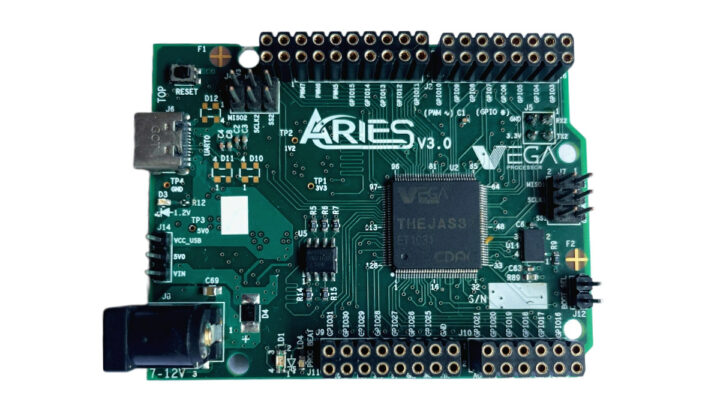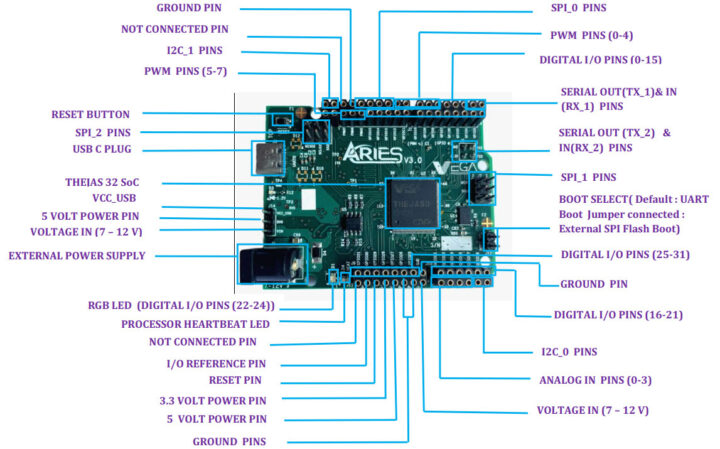ARIES v3.0 is an Arduino-inspired development board with the made-in-India 100 MHz THEAJS32 ASIC with the VEGA ET1031 RISC-V microprocessor, 256KB of internal SRAM, and various I/Os. Not to be confused by the recent FIVEberry RISC-V SBC made by ARIES Embedded…
We first wrote about VEGA RISC-V processors designed in India in February 2022, and at the time, the government worked on five RISC-V processor designs ranging from a single-core 32-bit RISC-V microcontroller-class processor to a Linux-capable quad-core 64-bit out-of-order processor, with the entry-level THEJAS32 and THEJAS64 SoCs based on respectively VEGA ET1031 and VEGA AS1061 cores running on an ARTY A7 FPGA board. But good progress has been made since then, and they have tapped out the THEJAS32 processor and manufactured some development boards such as the ARIES v3.0.
ARIES v3.0 development board specifications:
- MCU – THEJAS32 VEGA ET1031 32-bit 3-stage in-order RISC-V ( RV32IM) microcontroller @ 100 MHz with 256KB SRAM
- Storage – 2MB SPI flash
- USB – USB Type-C port for programming
- Expansion
- Arduino UNO-like headers with up to 32x GPIOs, 8x PWM, 4x analog inputs, 1x SPI, 3x UART, 2x I2C
- 2x 6-pin SPI headers
- DC Current per I/O Pin – 12 mA
- I/O Voltage – 3.3 V
- Misc – Reset button, Boot select jumper (UART or SPI flash), CPU heartbeat LED, RGB LED
- Power Supply – 7-12V DC via a power barrel jack or header
- Dimensions – 78 x 66 mm
The board is programmable in the Arduino IDE, and you just need to add a board manager URL to enable support, as explained in the documentation which only lists Windows 10 64-bit or above as the supported host, so it’s quite possible the toolchain won’t work on Linux or macOS just yet.
The Centre for Development of Advanced Computing (C-DAC), funded by the Ministry of Electronics and Information Technology, Government of India, says the board targets low-power IoT, sensor fusion, Smart Meters, System supervisors, Remote sensors, Wearable devices, toy and electronic education equipment, legacy 8/16-bit applications, industrial networking, and more…

The ARIES v3.0 development board is actually the fourth board based on the THEJAS32 RISC-V MCU, and there’s also an IoT model with u-Blox NINA-W10 WiFi 4 and Bluetooth 4.2 module. You’ll find more details on the product page, and if you are in India or know somebody there, you may be able to register and purchase one or more boards for around 1,000 Rs each, or about $12.

Jean-Luc started CNX Software in 2010 as a part-time endeavor, before quitting his job as a software engineering manager, and starting to write daily news, and reviews full time later in 2011.
Support CNX Software! Donate via cryptocurrencies, become a Patron on Patreon, or purchase goods on Amazon or Aliexpress. We also use affiliate links in articles to earn commissions if you make a purchase after clicking on those links.






Are those machine pin sockets? That’s the wrong kind of socket to use for pin type connectors. You want a ‘tuning fork’ type spring socket.
Interesting board format/layout choice. It’s like they sort of want to be arduino UNO compatable, but didn’t quite understand what that meant.
And a 128 pin TQFP? That’s a pretty hefty package for this. I’m curious what all the pins are needed for. Does it have a lot more I/O that doesn’t make it to I/O pins or does it have an overly healthy # of power and ground lines?
The design just looks akward like those early UNO+ESP8266 board where the ESP-12 module was just glued to the side.
Can we have with higher memory? What is the cost?
Wondering if the documentation for the uC is better than Chinese average…
Might try to get one in autumn as I might end up in India around that time.
How sad… No information online, no datasheet, just some sdk tutorials. I guess no need to import e-waste. Maybe in 2 or 3 years if it survives until then… Really disappointing
You may find its datasheet on website
Just Google vega processor
And there you will find its datasheet also buy link if you want to buy it
The 2 pages datasheet or a proper one with several hundreds of pages? Just dreaming about AVR for example.
The one I found (probably same as you did) has no pinout, no absolute maximum ratings, nothing. Not even the basic circuit to operate the uC can be deducted from there. Leave alone register definitions, peripherals, memory map…
The documentation indeed is lacking. They do have an SDK available, but you need to ask first for access.
I am mantaining a fork of it with additional needed improvements. Documentation will soon follow.
https://github.com/rnayabed/taurus
also wrote a companion uploader tool to work with it, since their official tool is proprietary.
https://github.com/rnayabed/vegadude
Both are highly WIP.
Official documentation or community docs? It is right now just an arduino toy, nothing serious.
Keeping fingers crossed they will realise soon throwing silicone on the market alone doesn’t do the job.
Community obviously. This is a play project for me as well, I am new to embedded students and felt this is a good starting project to learn from. If they think it’s decent I hope they would merge it to upstream.
Yes obviously its a play thing, I don’t think any company will use this over existing options in the market. the only MSP here is that it’s locally designed and made. The weirdest quirk is that there is no debugging/JTAG support at all. The SoC itself supports it according to datasheet, but the board hardwires all the jtag pins to ground.
Most likely the government will try to adopt it in their projects I guess. I am not sure.
Just in case anyone else is curious, from what I can tell the MCU is “made in India” in the same way that Apple products are “made in USA”, ie the design is done in India but it is actually made into silicon in Malaysia.
I have been to one of their workshops IRL, you are right. THEJAS32 is fabricated in foreign foundries. However, I vaguely remember about them saying some other model to be locally fabricated, sadly I do not remember the name exactly.
I’m reading some news about an Indian fab being launched this year. Will the THEJAS32 be manufactured there going forward?
Maybe, I am not sure. I am just a student haha.
Most likely fabbed in Taiwan, and packaged in Malaysia.
I guess that’s ok for a start, also most Chinese semis are/were made in Taiwan